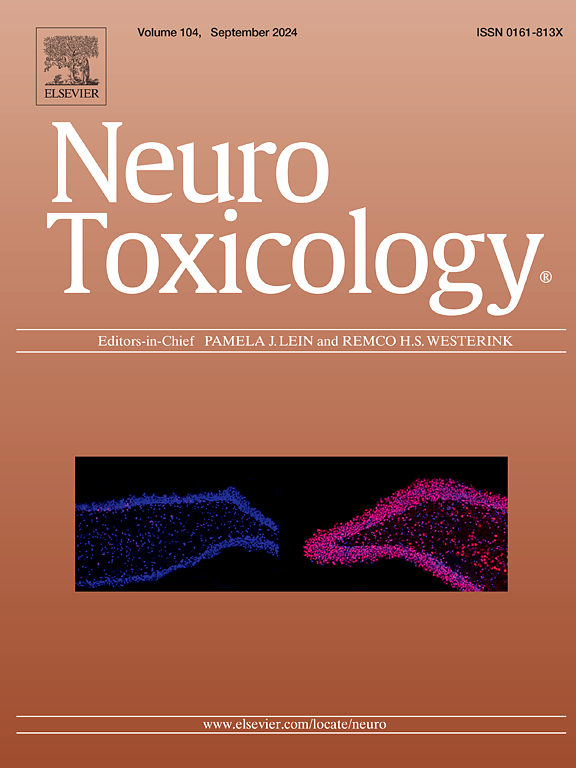Multi-behavioral fingerprints can identify potential modes of action for neuroactive environmental chemicals
IF 3.9
3区 医学
Q2 NEUROSCIENCES
引用次数: 0
Abstract
There is a lack of confidence in the relevance of zebrafish-based behavior data for chemical risk assessment. We extended an automated Visual and Acoustic Motor Response (VAMR) new approach method (NAM) in 5-day post-fertilization (dpf) zebrafish to include 26, behavior-based endpoints that measure visual-motor responses, visual and acoustic startle responses, habituation learning, and memory retention. A correlation analysis from 5159 control larvae revealed that more complex endpoints for learning- and memory-related behavior yielded unique behavior patterns. To build confidence in the VAMR NAM, we established neuroactivity fingerprints using concentration-response profiles derived from 63 reference chemicals targeting neurotransmission, neurodevelopmental signaling, or toxicologically-relevant pathways. Hierarchical clustering revealed diverse toxicity fingerprints. Compounds that targeted the N-Methyl-D-aspartic acid (NMDA) or gamma-aminobutyric acid type A (GABAA) receptors reduced habituation learning. Pathway modulators targeting peroxisome proliferator-activated receptor delta (PPARδ) or gamma (PPARγ), GABAA, dopamine, ryanodine, aryl hydrocarbon (AhR), or G-protein-coupled receptors or the tyrosine kinase SRC inappropriately accelerated habituation learning. Reference chemicals targeting GABAA, NMDA, dopamine, PPARα, PPARδ, epidermal growth factor, bone morphogenetic protein, AhR, retinoid X, or α2-adreno receptors triggered inappropriate hyperactivity. Exposure to GABAA receptor antagonists elicited paradoxical excitation characterized by dark-phase sedation and increased startle responses while exposure to GABAA/B receptor agonists altered the same endpoints with opposite directionality. Relative to reference chemicals, environmental chemicals known to be GABA receptor antagonists (Lindane, Dieldrine) or agonists (Tetrabromobisphenol A (TBBPA)) elicited predicted behavior fingerprints. When paired with the phenotypically rich VAMR NAM, behavior fingerprints are a powerful approach to identify neuroactive chemicals.
多行为指纹可以识别神经活性环境化学物质的潜在作用模式。
基于斑马鱼的行为数据与化学品风险评估的相关性缺乏信心。我们在受精后5天(dpf)的斑马鱼中扩展了自动视觉和声学运动反应(VAMR)新方法(NAM),包括26,000个基于行为的端点,这些端点测量视觉-运动反应、视觉和声学惊吓反应、习惯学习和记忆保留。对5159只对照幼虫的相关分析显示,学习和记忆相关行为的更复杂端点产生了独特的行为模式。为了建立对VAMR NAM的信心,我们利用63种针对神经传递、神经发育信号或毒理学相关途径的参考化学物质的浓度-反应谱建立了神经活动指纹图谱。分层聚类揭示了不同的毒性指纹图谱。针对n -甲基- d -天冬氨酸(NMDA)或γ -氨基丁酸A型(GABAA)受体的化合物减少了习惯学习。靶向过氧化物酶体增殖体激活受体δ (PPARδ)或γ (PPARγ)、GABAA、多巴胺、ryanodine、芳烃(AhR)或g蛋白偶联受体或酪氨酸激酶SRC的途径调节剂不适当地加速了习惯化学习。靶向GABAA、NMDA、多巴胺、PPARα、PPARδ、表皮生长因子、骨形态发生蛋白、AhR、类视黄醇X或α2肾上腺素受体的参比化学物质会引发不适当的过度活跃。暴露于GABAA受体拮抗剂会引起以暗相镇静和惊吓反应增加为特征的矛盾兴奋,而暴露于GABAA/B受体激动剂会改变相同的终点,但方向相反。相对于参比化学物质,已知的GABA受体拮抗剂(林丹,狄氏碱)或激动剂(四溴双酚A (TBBPA))的环境化学物质引发了预测的行为指纹。当与表型丰富的VAMR NAM配对时,行为指纹是识别神经活性化学物质的有力方法。
本文章由计算机程序翻译,如有差异,请以英文原文为准。
求助全文
约1分钟内获得全文
求助全文
来源期刊

Neurotoxicology
医学-毒理学
CiteScore
6.80
自引率
5.90%
发文量
161
审稿时长
70 days
期刊介绍:
NeuroToxicology specializes in publishing the best peer-reviewed original research papers dealing with the effects of toxic substances on the nervous system of humans and experimental animals of all ages. The Journal emphasizes papers dealing with the neurotoxic effects of environmentally significant chemical hazards, manufactured drugs and naturally occurring compounds.
 求助内容:
求助内容: 应助结果提醒方式:
应助结果提醒方式:


